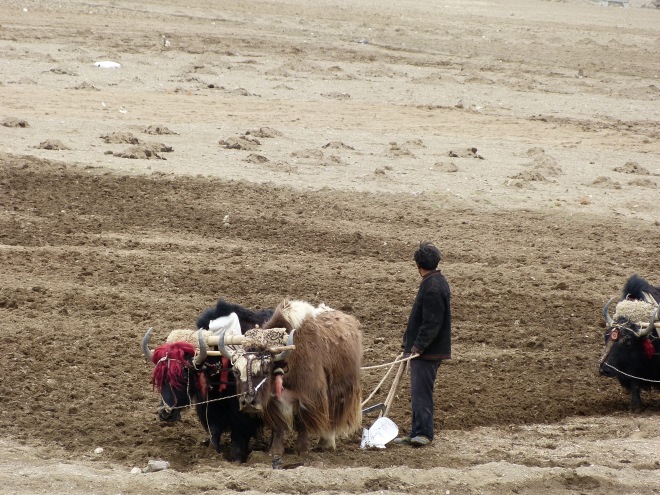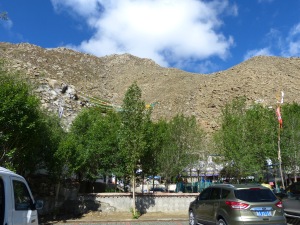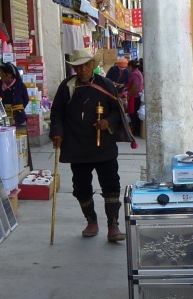I’ve been home for a little more than a week. It took almost that long to get back to normal after seven days in Tibet.
I expected to love Tibet. I WANTED to love Tibet. Sadly, very sadly, I didn’t.
Have I turned into an “ugly American”, critical of a country when it isn’t like home? I certainly hope not.
It is entirely possible that I was spoiled by the fantastic guides and the wonderful experiences we had in Bhutan and Nepal, and expected more of the same. Or maybe it was because for the first three days in Lhasa, I was fighting a cold and the Tibetan’s version of Montezuma’s revenge, adjusting to the altitude and possibly reacting to the Diamox I’d taken for altitude sickness. Whatever it was, I was not feeling great. I missed two afternoons of sightseeing in Lhasa so I could sleep my way to feeling better.
Although I had read up on Tibet and had checked the Overseas Adventure Forum before booking the trip, there were still a few surprises. After much soul searching, I’ve uncovered what might have influenced my feelings about Tibet, AND am offering some tips so that future travelers might make their experience more enjoyable.
The China Factor
Knowing that China had taken over Tibet was not the same as experiencing the impact of that takeover. This is the closest I’ve ever come to being in a police state. Those two white objects on the dashboard are cameras–one pointed inward so the police could monitor what was going on in our van whenever they wanted.

And yes, that IS a military convoy, in front of us, hauling big guns. Although you can’t see it in the photo, in every truck, two soldiers were pointing their weapons out the back. I was very grateful the road wasn’t bumpy!
Although the hotel in Lhasa offered free wifi, we quickly discovered that google, yahoo, safari, the New York Times, and many email accounts were blocked by the Chinese government.
Being under constant surveillance has to have an impact on the psyche of the population, and I believe it did. Unlike Bhutan and Nepal, the people in Tibet didn’t seem as interested in interacting with tourists. Or maybe they were afraid.
Tip: If it is important to stay in contact with family back home, set up a hotmail account. For some reason, that email service wasn’t blocked. Also, texting works. My iPhone allowed me to send free “imessages”!
Altitude and Air
The air is very dry because of the altitude and very smoky from cigarettes and incense. Everyone smokes everywhere–in the hotels, restaurants, on the street. It was like being trapped in a Mad Men episode, but with different costumes. You can request a non-smoking hotel room, but there is no guarantee that you will get anything other than a smoking room sprayed with air freshener. 
If the cigarette smoke doesn’t get you, then the incense and Yak butter candles in the temples will.
At times, inside the temples and monasteries, I found it challenging to breathe.

And if you think stepping outside to breathe in fresh air would help, think again. These little chimneys for burning incense are everywhere!
 Tip: The 5th floor of the Xin Ding Hotel is the only nonsmoking floor. The other hotels don’t have that option, but 4 of the 7 nights are spent in the Xin Ding, so it is worth it to request a room on the 5th floor. If you’re lucky, you’ll get a wonderful view of the Potala from your room.
Tip: The 5th floor of the Xin Ding Hotel is the only nonsmoking floor. The other hotels don’t have that option, but 4 of the 7 nights are spent in the Xin Ding, so it is worth it to request a room on the 5th floor. If you’re lucky, you’ll get a wonderful view of the Potala from your room.
The hotel makes sure you can buy whatever you need without leaving the comfort of your room: toothpaste, manicure tools, condoms, mysterious things in plastic bags with Chinese writing on the front…
Long Drives in a Small Van over a Barren Landscape
Fortunately, no one in the group was very large. At 5’8″, I was the tallest. If my 6’3″ husband had been with us, the 8 hour drives from and to Lhasa would have been quite uncomfortable for him.

But the size of the van wasn’t the problem. No, the challenge was the lack of bathroom facilities along the way. Not only that, but we quickly discovered that squat toilets were the only option. The good news? You never had to ask for directions. All you had to do was follow your nose. Another plus? Many of them had no stalls or partitions, so you could make new friends while emptying your bladder. Let me tell you, it was much more pleasant to look at my neighbor’s backside than to look down at what had taken place before I arrived.
It didn’t take long for me to decide that a bush, a rock or a tree was far preferable to the few roadside bathroom facilities. Did I mention that I was drinking more water than usual because of my cold, the dry air and the altitude medication? Those were LOOONG drives!
Tip: Tiger Balm or Vicks applied under your nose blocks out all other smells. Unfortunately, I had neither with me. Women need to practice their squats before embarking on this trip!
The landscape on the drive to Gyantse was rather stark.

 Our guide had to stop at multiple police check points along the way to show our passports and to complete paperwork, and to have our speed monitored. I didn’t think that was a bad thing, given the narrow winding mountain roads, but Marilynn disagreed. When our driver and guide took a cigarette break, leaving the keys in the van, she offered to take over and get us to the hotel in record time!
Our guide had to stop at multiple police check points along the way to show our passports and to complete paperwork, and to have our speed monitored. I didn’t think that was a bad thing, given the narrow winding mountain roads, but Marilynn disagreed. When our driver and guide took a cigarette break, leaving the keys in the van, she offered to take over and get us to the hotel in record time!
Here are the notable sights during our 8 hour drive to Gyantse.



Tip: My iPod was my salvation; our guide and driver talked to each other in Tibetan for much of the way, so I was grateful I could plug in and listen to music instead.
Our Guide
Tibet has many wonderful myths and legends; I was looking forward to hearing our guide elaborate and offer the local version of the stories I’d read. Unfortunately, he either was not allowed to relate them to us, or perhaps during the 50+ years since China invaded, the legends stopped being passed along. He certainly couldn’t access Wikipedia to supplement his knowledge!

For example, our guide told us this unspectacular pile of rocks is Mt. Kalish. According to Google, Mt. Kalish is located in a very remote part of Tibet, and is visually spectacular. That “mountain” was neither. But Tibetans do circumambulate its perimeter, and it has been the locale for “sky burials”. (A few days after someone dies, the body is cut up, brought to the mountain top and left for the vultures to consume, thereby completing the circle of life.)
I had hoped to learn more about the Goddess that was transformed into Yamtrok Lake, but once again, our guide wasn’t able to elaborate, so here’s what I learned from my reading. After arguing with her husband, a goddess decided to leave him forever by turning herself into a lake. Boats are not allowed on Yamtrok because the vessel would slice her skin. I also learned that Tibetans believe if the Lake ever goes dry, all Tibetans will perish.

After returning home, I turned to Google, where I discovered that senior monks go to Yamtrok Lake after the Dalai Lama’s death. They throw sacred objects into the lake, then watch for a reflection that will tell them where to find the next (reincarnated) Dalai Lama.
Tip: Learn everything you can about the culture and myths before coming to Tibet. The information the guide imparts could be very limited.
Food
You don’t travel to Tibet for the food. There is a reason Tibetan restaurants aren’t popping up in major cities, still, we had hoped for great Chinese food. Two of our group were born in Hong Kong, spoke and read fluent Mandarin. They were not fans of the cuisine.
Be prepared for very basic meals, with no snacks in between. There isn’t much fruit, however I discovered that you CAN buy bananas.
Tip: I had brought granola bars, but shared them with the other travelers during our long rides in Bhutan and Nepal. By the time we reached Tibet, my stash was gone. Big mistake. It’s a good idea to bring packaged snacks.
The Locals
For me, interacting with the locals, especially children, is always a high point of my trips. Unlike in Bhutan and Nepal, opportunities to interact were limited.
While in Shigatse, I spent our two free afternoons wandering through the city. I was taking photos of the street when I was accosted by an old man with a walking stick in one hand and a prayer wheel in the other.

He was yelling at me, and for a moment I was afraid he was going to hit me. He apparently thought I had photographed him–although the truth was I didn’t even notice him. I was more interested in the goods on the sidewalk. End result? There are no photos of Tibetan people.
But I didn’t let that one unfortunate incident keep me from trying to interact with the locals.

I had learned to say “Tra-shi-de-lay”, which is close enough to the Tibetan greeting to occasionally get a smile.
During my second afternoon purchasing bananas, I noticed a Tibetan trying to take a picture of me with her cell phone, so I posed for her. Out of the corner of my eye, I caught a young man attempting to get into the photo, so I turned, threw my arms around his neck and put my cheek next to him. And the crowd went wild! Not only that, but I got my bananas for half of what I had paid the day before. Sorry, no photos of that exchange because I had left MY camera back in the room. I didn’t want to take a chance of being smote with a stick!
Tip: Learn a couple of Tibetan words, smile and see if you can make a connection.
That’s all for today. Next post will be more upbeat, I promise. There will be photos of what made the trip special.




Wow- this was a different but very educational post ….the suppressed people of Tibet – I did not know the extent.
LikeLike
Thanks Jean,
It was a really hard one to write.
LikeLike
Too bad this experience wasn’t better. I missed you.
LikeLike
Wow! This doesn’t sound like a typical OAT tour. I’m surprised that they sponsor a trip to Tibet, since they cannot follow their usual MO of interacting with the locals, etc. However, you had a true once-in-a-lifetime experience. Looking forward to your next post. 😃
LikeLike
Sorry your trip to Tibet was such a disappointment. What China has done to the Tibetans is deplorable. It is unfortunate that their control has reached such an extent that one can not see any of the beauty that may still remain in Tibet. It is too bad that QAT did not prepare you for the fact that you wouldn’t be able to interact with the people and culture in the way you are used to because of the “Great Wall” the Chinese government has enforced on communication with the outside world. They are concerned that journalists come disguised as tourists and will go home and publish pictures and stories about the ugly situation in Tibet between the beautiful and gentle Tibetans and the fury and dominance of the Han Chinese. Tibetans must be very careful about what they say to a foreigner….yes they do fear for their life if they do not speak the Party line.
LikeLike
You are so right, Marilyn. I Suspect that Tibetans were afraid to have any contact with us. It was definitely a unique trip and a real learning experience. I realize how much I take for granted here in the USA and am so grateful that I was born in this country!
LikeLike
Thanks Shelley. Too bad it was not all you had hoped. As mentioned, I am hoping to follow in your footsteps — definitely Bhutan and Nepal, but perhaps not Tibet. I will be writing about my visit to Dharamshala, India, where the Dali Llama and many Tibetan refugees now live.It was fascinating, but tragic.
LikeLike
Wow, maybe I shouldn’t regret not making it to Tibet. Loved your photo stoary! Can’t wait to see you!
LikeLike
Story not stoary
LikeLike
Thanks for sharing your experiences with us.
LikeLike
Hey Karen, It’s so nice to hear from you. I miss my old book club!
LikeLike
Fascinating trip report! I’m sorry it was a bit on the sour side and you weren’t feeling well… I’m anxious to hear about the good stuff now. 🙂
LikeLike
Thanks AGMA, Well, there IS a positive side to having a trip that is not uniformly wonderful. you are SO glad to get home, AND you really, really appreciate the fantastic time you had in the other countries even more!
LikeLiked by 1 person
Yikes! Too bad that experience was at the end of your journey. I don’t think you need to worry about being an “ugly American.” Expecting your guides to offer accurate and educational information is not unreasonable.
LikeLike
I appreciated your well expressed honesty, Shelley, and the fact that you gave tips for avoiding, or lessening the negative impact, of some of the conditions you encountered. By describing things that were less than pleasant and what can be done about them, you make all of us better-informed travelers.
LikeLike
Thanks Janet,
I really believe in giving back. I have benefited greatly from the generosity of other bloggers, reviews on trip advisor and comments on the OAT Forum that I wanted to do likewise for someone else. That’s what’s so wonderful about the internet–being able to share experiences and learn from each other.
LikeLike